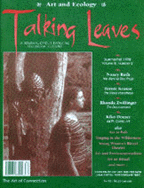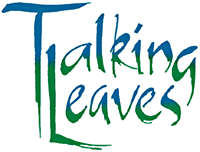

In our first article section, The Art of Connection, we hear about personal experiences of the confluence of art and ecology. In the opening piece, Kiko Denzer simply and poetically addresses many of the themes you'll find explored throughout this issue, reminding us that "Earth--saturated by rain, warmed by sun, inspired by wind--is the source of beauty." Nancy Roth shows that music, dance and the visual arts can help children and adults alike find their place in the "circle of creation," giving us the tools of listening, observing, seeing, and moving, and inspiring us to communicate and deepen our relationship with the earth. In a wide-ranging narrative/reflection which starts with Amtrak and ends with Zucchini, Chris Roth discovers that, in art and in life, everything is connected (apparently unwilling to take his mother's word for it, he had to experience it for himself). Jules Bubacz joins Joanne Rand and Angie Curtes in the wilderness to find connection with nature and with one another through art and song, "our intuitive voice." Kestrel Gates travels further, to a different culture, to discover new perspectives on creativity and community and to get an opportunity, through art, "to let go of the self-centered nature" that separates us from one another and the world. And Hannah Fox describes movement, theatre, and all forms of art as tools for transformation and growth, sharing her work with the Young Women's Ritual Theatre and her own cross-cultural perspectives.
In our second section, Art as Environmental Statement, we explore how the arts can stimulate environmental awareness and social/political change. Katherine Kormendi provides a broad overview of the Ecological Art movement, detailing some of the most exciting work being done in this growing field (including reclamations, reawakenings, recyclings, dramatizations, and rituals/performances). Andrew Rodman issues a call for the creation of activist art, proposing that "Good art celebrates diversity and original thought... often turns our attention to the culprits of environmental and social ills," and makes us think and act. Thomas Webb of Orlo and the Guerilla Girls offer concrete examples of exactly the kind of art that Rodman is writing about: art which combines honesty, humor, and a willingness to be "out there" in challenging the status quo. And Rhonda Zwillinger describes her work using art to promote awareness of a specific, often-ignored, but widespread environmental problem, which has transformed both her art and her life: Multiple Chemical Sensitivities.
In our final article section, The Nature of Art, our authors delve deeper into the questions: what is art? where does it come from? how can it bring us into ecological harmony? David Rothenberg asks whether nature-based art can be "more than propaganda," and suggests that the best art "doesn't take away from the exact ambiguity that nature is best at, but reveals it to us," citing Japanese gardens and the song of the shakuhachi flute as examples of "art that works like nature works." Bernie Krause traces human music back to the music of the wilds, finding "biophonies" in nature that dwarf the efforts of even the best sonic artists in Western culture, and are rivaled only, in his experience, by the music of peoples who dwell within natural aural environments. Jesse Wolf Hardin ties all these threads together again, reminding us that art is sacred ritual, a way of living, born of the earth, and connecting us with earth--ultimately leading us, as participants, to beauty, gratitude, grace, and hope.
The extensive book and music review section further addresses many of the themes that run throughout our articles, specifically: the centrality of music in our experience (see "Book/Music Packages," "Books About Music," and "Music" reviews), the role of various other art forms in expressing and affirming ecological relationships (see "Books About Art," which run the gamut from painting to gardening, writing to blacksmithing), and (only slightly tangential to our main subject) what other animals might say about all this ("Books About Animals").
Thankfully, the poems and artwork in this issue speak for themselves. We appreciate the many submissions of poetry, artwork, and articles from readers--please keep them coming!
�1998 Talking Leaves
Summer/Fall 1998
Volume 8, Number 2
Art and Ecology
We welcome your letters!
For a sample copy of the Summer/Fall 1998 issue, "Art and Ecology," send $6 to
